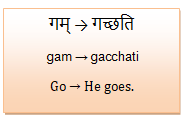The most amazing thing about Sanskrit is that it gives the option to create new words. In this way, it makes sure that there is a specific verb for every occasion and action. There are, however, 2000 verbs in Sanskrit, but to form complex idea and sentences, it is required to make new verbs and this is done by forming a new word in front of verb root. That new word/term is known as “prefix”. There are in general 20 different prefixes and each prefix has a different meaning altogether. So let’s take a look at some of the example.
So this is a simple sentence describing an action of going. Now let us see how it can be transformed.
Apart from the above example, we can also use multiple prefixes in a word to portray complex meaning.
It can be done to put more emphasis on the word. For instance, ‘upa’ here emphasizes on ‘going’ or ‘doing an action’ other translations can be “approach in order to assemble” or “go in order to meet” however, if, given the option, a shorter option is more appropriate to chose.
Consider the following example; Another factor is that the prefix that is close to the verb generates more emphasizes.
Another factor is that the prefix that is close to the verb generates more emphasizes.
However, it is not necessary that prefix generates importance in all the cases. In some rare cases, prefix does nothing much.
To understand prefixes more, let us first study some common verb prefixes that usually appear in the sentences
आगम् → आगच्छति
āgam → āgacchati
Come → He comes
उपगम् → उपगच्छामि
upagam → upagacchāmi
Approach → I approach
संगम् → संगच्छन्ति
saṃgam → saṃgacchanti
Come together, assemble → they assemble
Apart from the above example, we can also use multiple prefixes in a word to portray complex meaning.
उपसंगच्छसि
upasaṃgacchasi
You go to meet (somebody).
It can be done to put more emphasis on the word. For instance, ‘upa’ here emphasizes on ‘going’ or ‘doing an action’ other translations can be “approach in order to assemble” or “go in order to meet” however, if, given the option, a shorter option is more appropriate to chose.
Consider the following example;
समुपगच्छसि
samupagacchasi
You approach together (with someone else).
Another factor is that the prefix that is close to the verb generates more emphasizes.
However, it is not necessary that prefix generates importance in all the cases. In some rare cases, prefix does nothing much.
To understand prefixes more, let us first study some common verb prefixes that usually appear in the sentences.
सम्
sam
“with”, “together”
(You must have heard this prefix in words such as, “samjaya”, “samskara”, or even in “samskrta”)
वि
vi
“Divided”, “apart”
| आ ā | “near”, “towards” |
|---|---|
| उप upa | “next to”, “under”, “below” |
You can find the presence of these prefixes in the second verse of “Bhagavad-Gita”.
दृष्ट्वा तु पाण्डवानीकं वि-ऊढं दुर्योधनस् तदा ।
dṛṣṭvā tu pāṇḍavānīkaṃ vi-ūḍhaṃ duryodhanas tadā
But then, having seen the army of the Pandavas arrayed, Duryodhana
आ-चार्यम् उप-सं-गम्य राजा वचनम् अब्रवीत् ॥
ācāryam upa-saṃgamya rājā vacanam abravīt
Approached his master and spoke this word.





